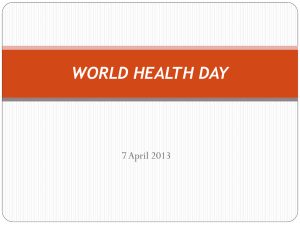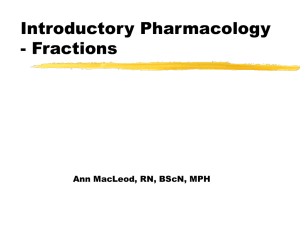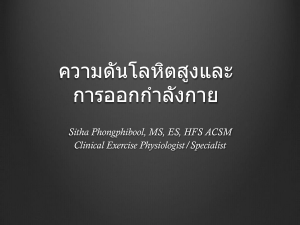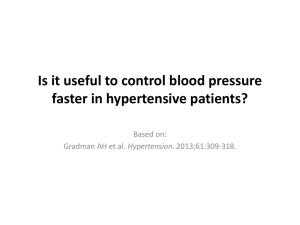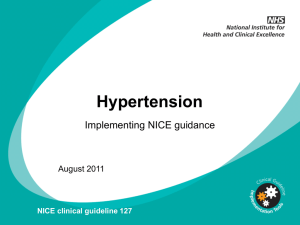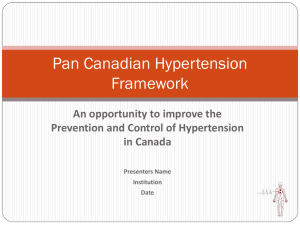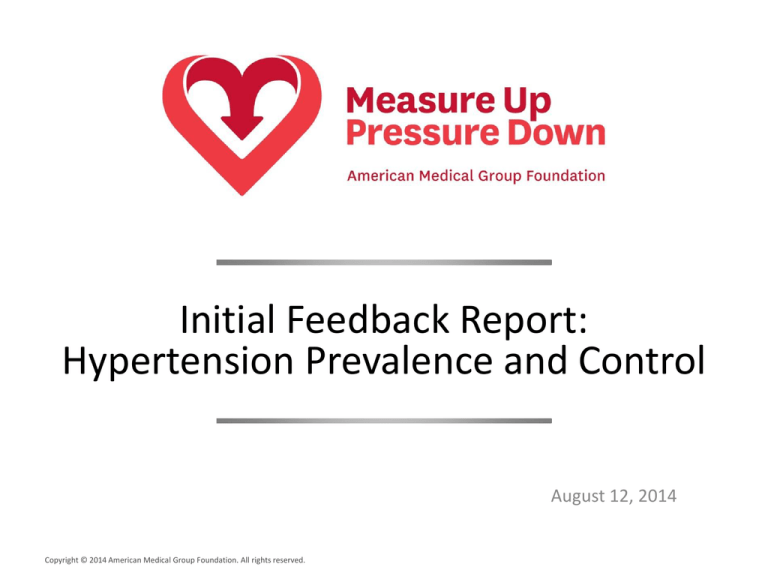
Initial Feedback Report:
Hypertension Prevalence and Control
August 12, 2014
Copyright © 2014 American Medical Group Foundation. All rights reserved.
Agenda
Quick review of measure specs
Seasonality
The data!
● Prevalence of hypertension
● Blood pressure control (< 140/90 mm Hg)
● Improvement 2013 Q1 → 2014 Q1
Known issues
Questions on data/reporting
Six Steps to Success
Copyright © 2014 American Medical Group Foundation. All rights reserved.
1
Anceta’s Measure Up/Pressure Down Data Team
John K. Cuddeback, MD PhD
Chief Medical Informatics Officer
202-297-9055 (mobile)
jcuddeback@amga.org
Cindy Shekailo
Program Director
703-838-0033 x361 (office)
cshekailo@amga.org
mupddataadmin@amga.org
Rich Stempniewicz
Chief Technology Officer
703-838-0033 x360 (office)
rstempniewicz@amga.org
Copyright © 2014 American Medical Group Foundation. All rights reserved.
Nikita Stempniewicz
Statistician
703-838-0033 x310 (office)
nstempniewicz@amga.org
2
Campaign Goal
Campaign goal: 80% of patients with hypertension have their BP in control
● Originally, by JNC 7 criteria
● Current approach: < 140/90 mm Hg for all patients (NQF 0018)
The percentage of patients 18 to 85 years of age who had a diagnosis of
hypertension and whose blood pressure was adequately controlled
(< 140/90 mm Hg) during the measurement year.
http://www.measureuppressuredown.com/Learn/Guidelines/jnc8PDF.pdf
Copyright © 2014 American Medical Group Foundation. All rights reserved.
3
Copyright © 2014 American Medical Group Foundation. All rights reserved.
4
Copyright © 2014 American Medical Group Foundation. All rights reserved.
5
Copyright © 2014 American Medical Group Foundation. All rights reserved.
6
Copyright © 2014 American Medical Group Foundation. All rights reserved.
7
Measurement Periods
40%
60%
Among hypertension patients seen during a 12-month period,
about 60% have their last office visit during the last 3 months.
Copyright © 2014 American Medical Group Foundation. All rights reserved.
8
Numbers to Report: Patient Counts
Prevalence = Denominator / Total Patients
Control = Numerator / Denominator
Copyright © 2014 American Medical Group Foundation. All rights reserved.
9
Patient Population
Total Patients — number of unique patients with 1 or more ambulatory E&M visits (including
“prevention” services) during the 12-month reporting period, using Table CBP-B: Codes to
Identify Outpatient Visits, from HEDIS® 2013 Technical Specifications for Physician Measurement:
99201–99205
99211–99215
99241–99245
99384–99387
99394–99397
Office or other outpatient visit, new patient
Office or other outpatient visit, established patient
Office consultation, new or established patient
Initial comprehensive preventive medicine visit
Periodic comprehensive preventive medicine visit
Numbers of patients are broken out by:
● Age category: 18–64 years, or 65–85 years, as of the end of the reporting period.
● By gender (male, female).
Copyright © 2014 American Medical Group Foundation. All rights reserved.
10
Exclusions (from the Population/Denominator)
Patients with unknown gender
Patients with unknown age, or age < 18 or > 85 years, as of the end of the reporting
period
Patients who had an admission to a non-acute inpatient setting any time during the
reporting period
Patients with evidence of end-stage renal disease (ESRD) during or prior to the end
of the reporting period
Patients who were pregnant during the reporting period
Copyright © 2014 American Medical Group Foundation. All rights reserved.
11
Denominator and Numerator
Denominator — number of patients in the population defined above who have a diagnosis of
essential hypertension:
● on patient’s problem list, any time prior to the end of the first six months of the reporting period
(rolling 12-month periods, ending each calendar quarter), or
● ICD-9-CM diagnosis code 401.XX on a claim associated with an ambulatory visit during (or before)
the first six months of the reporting period, where one of the specified CPT codes is billed.
Numerator — number of patients in the denominator whose last ambulatory, in-office BP during
the reporting period is < 140/90 mm Hg.
Note: Where multiple BP readings are recorded on a single day, take the lowest systolic reading and the
lowest diastolic reading for the day.
Exclusions —
● Exclude BP readings from inpatient, observation, and ER settings. (Include urgent care.)
● Exclude home BP readings and ambulatory BP monitoring data.
● Exclude BP readings taken prior to diagnosis of HTN (where feasible, examine the patient’s
entire longitudinal record for the first occurrence of a 401.XX diagnosis code, or consider the
date when hypertension was added to the patient’s problem list, whichever is earlier).
● Exclude from the numerator patients with no BP measurement recorded during the reporting
period. Patients with no BP measurement during the reporting period are considered not in
control, since they are not known to be in control.
Copyright © 2014 American Medical Group Foundation. All rights reserved.
12
Seasonality – Data from 2012
Blood pressure is higher (and hypertension control is worse) during winter months (Q1 and Q4)
So we’ll compare the 12 months ending 2014 Q1 to the 12 months ending 2013 Q1
Copyright © 2014 American Medical Group Foundation. All rights reserved.
Quarter (of 2012)
13
Missing BP — Special Case
NQF 0018: In general, BP not recorded is considered to be “not in control”
Some groups have a few sites or providers who are not using the EHR to record BP
or other clinical observations
If the vast majority of the organization’s providers are using the EHR to record BP,
the following are acceptable:
● Provider-level approach—If the provider for last E&M encounter during reporting
period does not record clinical observations in the EHR, exclude the patient from the
denominator
● Patient-level approach—If no BMI (height/weight) or other clinical observation (TPR,
pain) for the patient, exclude the patient from the denominator
If a substantial number of an organization’s providers are not recording clinical
observations in an EHR, NCQA’s hybrid method may be used. (Please contact
MU/PD data team to discuss.)
Copyright © 2014 American Medical Group Foundation. All rights reserved.
14
15
16
17
18
Questions on data/reporting?
19
Six Steps to Success
Action Plan
Six Steps to Success
Action Plan
Summit Medical Group
Example of Success
100%
Hypertension: Patients in Control (BP<140/90)
78%
79%
May-14
Jun-14
74%
Apr-14
Jan-14
73%
76%
Mar-14
69%
70%
2013 Baseline
80%
Feb-14
by Month Primary Care
60%
40%
20%
Dec-14
Nov-14
Oct-14
Sep-14
Aug-14
Jul-14
0%
Step 1: Give JAMA Article to
All Physicians
Improvement:
2001: 44%
2011: 87%
Impact:
Heart attacks: Declined by 24%
Fatal strokes: Declined by 42%
Takeaways:
Create a registry
Share best practices
Use treatment algorithms
Give patients easier-to-use
medications
No-cost follow-up care
Step 2: Disseminate monthly
physician reports
Step 3: Re-engage all in
proper BP technique
Step 3: Re-engage all in
proper BP technique
Step 3: Re-engage all in
proper BP technique
Step 4: Create a two-week
follow-up process
Step 5: Adopt and promote
hypertension protocols
Step 6: Use patient
engagement tools
Step 6: Use patient
engagement tools
Campaign Resources
MeasureUpPressureDown.com
Facebook, Twitter, Flickr
For Healthcare Professionals:
⁻ Provider Toolkit
⁻ Monthly webinars
⁻ One-on-one group calls
For Patients:
⁻ Circulation Nation: Your
Roadmap to Managing High
Blood Pressure
⁻ 10 patient tip sheets
Questions?





